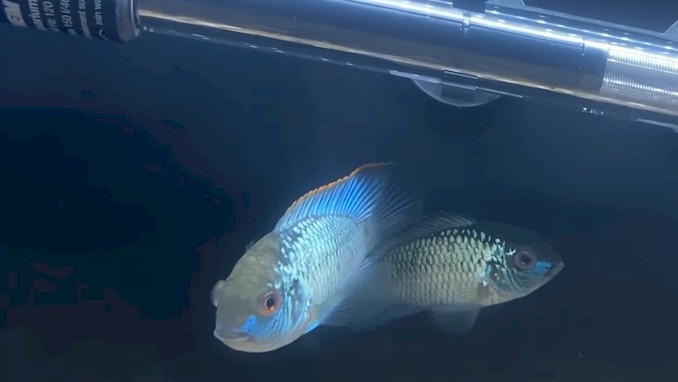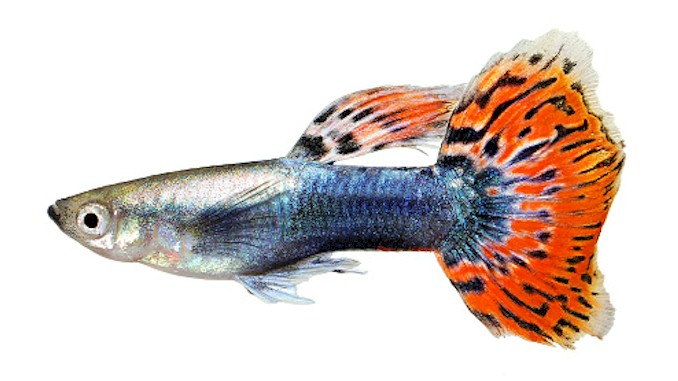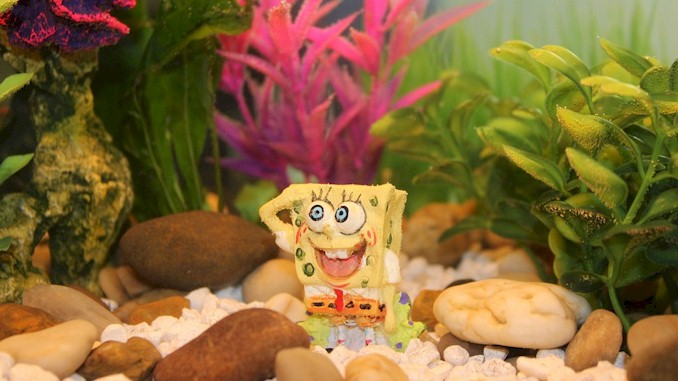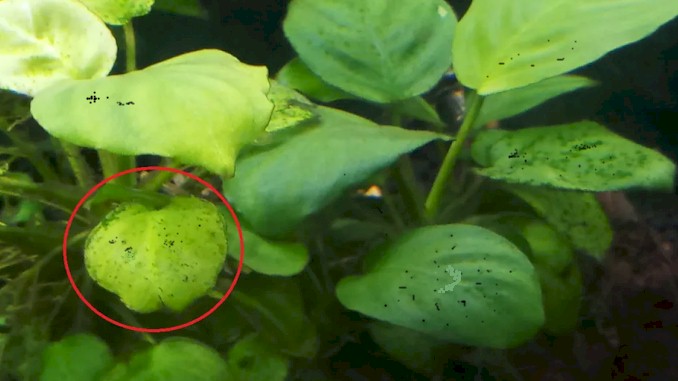Top 10 Beginner-Friendly Aquarium Plants for Guppy Tanks
When I first started keeping guppies, I bought some plants from a pet store without doing any research. I thought they looked nice and they were cheap. But soon I realized that they were not good for my guppies at all. That’s when I decided to do some research and find out which plants are the best for guppy tanks. I read a lot of articles online, watched some videos on YouTube, and asked some experts on forums. In this article, I want to share with you what are the best and easy-to-care-for plants for your guppy tank.
The best and easy-to-care-for plants for your guppy tank are: Java moss, Anubias,Anacharis, Water Lettuce, Hornwort, Java fern, Guppy Grass, Amazon Sword, Cryptocoryne, Dwarf Sagittaria. These plants are all relatively low-maintenance and can thrive in a variety of conditions, making them ideal for beginners.
These plants are not only easy to care for, but they also provide a variety of benefits for guppies, such as providing hiding places, oxygenating the water, and helping to control algae growth. And they are also beautiful. Well, I learned this the hard way. I learned a lot about different types of plants, their requirements, their benefits, and their drawbacks. I also learned how to plant them properly, how to care for them, and how to prune them. It took me some time and effort, but it was worth it. If you want to have a guppy tank like mine, you don’t have to go through the same trial and error that I did. You can just follow my advice and choose from the top 10 beginner-friendly aquarium plants for guppy tanks that I’m going to share with you in this blog post. So read on and find out.
10 Beginner-Friendly Aquarium Plants for Guppy Tanks
These plants are generally forgiving when it comes to water parameters and lighting conditions, making them ideal for beginners. However, remember that even easy-to-care-for plants require some attention, so regular trimming, removal of dead leaves, and maintenance are important for a healthy and beautiful aquarium.
Here are the top 10 beginner-friendly aquarium plants for guppy tanks, with their names, pictures, and brief descriptions.
1. Java moss
Ideal for creating a natural look, Java moss can be tied to objects like rocks and driftwood. It’s low-maintenance and provides hiding spots for guppy fry. It can grow on any surface. It can also help filter the water and prevent algae growth.
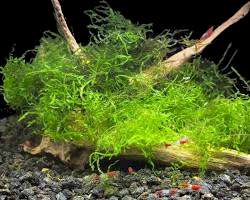
2. Anubias
Another easy-to-care-for plant that can be attached to hardscape. It’s known for its broad, thick leaves and can tolerate various lighting conditions. A hardy plant that can tolerate low light and high temperatures. It has thick leaves that are not eaten by guppies and can be attached to rocks or driftwood.
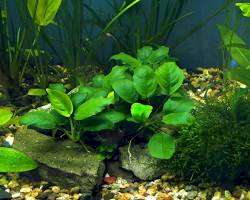
3. Anacharis
This plant is also known as Elodea. It is a fast-growing plant that can provide cover for guppy fry and help to oxygenate the water. Anacharis can be planted in the substrate or allowed to float freely in the tank.
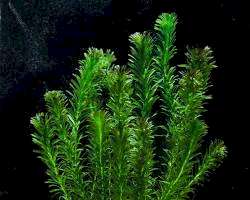
4. Water Lettuce
This floating plant provides shade and cover for guppy fry. It also helps to keep the water cool and clean. Water lettuce can be easily propagated by simply cutting off a piece and letting it float in the tank.
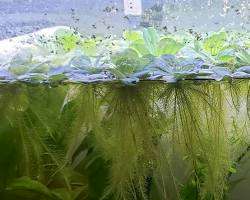
5. Hornwort
This plant is a good choice for tanks with low light levels. It is a fast-growing plant that can provide cover for guppy fry and help to oxygenate the water. Hornwort can be planted in the substrate or allowed to float freely in the tank.
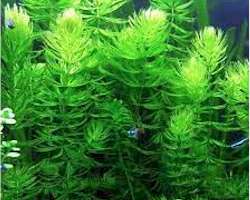
6. Java fern
This is a hardy plant that can be attached to driftwood or rocks. It thrives in low to moderate light conditions and doesn’t require special substrates.

7. Guppy Grass
This is a fast-growing plant that is perfect for providing cover for guppy fry. It can be planted in the substrate or allowed to float freely in the tank. Guppy grass is also a good choice for tanks with low light levels.
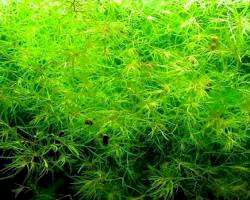
8. Amazon Sword
This is a large plant that can create a focal point in the tank. It has long and broad leaves that offer shade and shelter for guppies, and are well-suited for background placement. They prefer nutrient-rich substrates and moderate lighting.
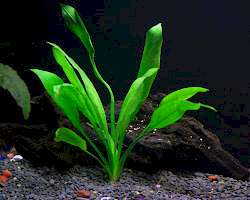
9. Cryptocoryne
This is a group of plants that come in different shapes, sizes, and colors. They have wavy and textured leaves that add variety to the tank. They need low to moderate light and substrate. They’re great for midground or foreground placement.
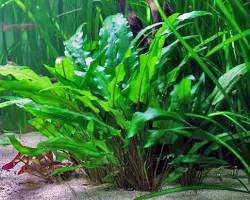
10. Dwarf Sagittaria
This is a grass-like plant that’s perfect for creating a carpet effect in your tank. It’s undemanding and can thrive in a range of lighting conditions.
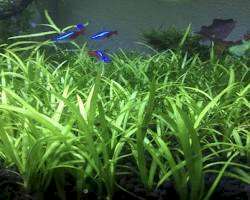
These are some of the best plants for guppy tanks that you can try as a beginner. They are easy to grow, they don’t need much maintenance, and they provide a natural environment for your guppies. You can mix and match them according to your preference and tank size.
Insight into each plant’s specific care requirements, lighting needs and growth patterns
Now that you have a general idea of the best plants for guppy tanks, you might want to know more about their specific care requirements, lighting needs and growth patterns. Different plants have different preferences and demands, so it’s important to understand them before adding them to your tank. Here is a brief overview of each plant, with some tips and tricks to help you grow them successfully.
Java Moss
Java Moss(Taxiphyllum barbieri) is a versatile and popular aquarium plant known for its ease of care and adaptability. Here’s an insight into its specific care requirements, lighting needs, and growth patterns:
Care Requirements:
- Substrate: Java Moss is unique among aquatic plants in that it doesn’t require substrate planting. Instead, it can be attached to various surfaces within your aquarium. Common choices include rocks, driftwood, mesh, or even decorations. It will naturally anchor itself over time.
- Water Parameters: Java Moss is highly adaptable and can thrive in a wide range of water conditions. It can tolerate soft to hard water and a pH range of approximately 6.0 to 8.0. Maintaining stable water parameters is more critical than achieving specific values.
- Temperature: It can thrive in temperatures ranging from 59 to 86°F (15 to 30°C), making it suitable for both tropical and cooler water setups.
- Fertilization: Java Moss is not a heavy nutrient consumer, but it can benefit from occasional liquid or root tab fertilization. However, it can also grow well in nutrient-poor environments.
- CO2: It doesn’t require added CO2 injection, but providing a stable source of carbon can promote faster growth.
Lighting Needs:
Java Moss is considered a low-light plant, which makes it an excellent choice for beginners and low-tech aquariums. Here’s what you need to know about its lighting requirements:
- Intensity: Low to moderate lighting is ideal for Java Moss. It can tolerate low light conditions, but providing moderate light will encourage denser growth.
- Duration: A photoperiod (the period of time the light is on) of 8 to 10 hours per day is generally sufficient for healthy growth.
- Light Spectrum: A spectrum with a color temperature around 6500K (Kelvin) is suitable for promoting healthy growth and the plant’s vibrant green color.
Growth Patterns:
Understanding how Java Moss grows can help you manage and style it within your aquarium:
- Growth Rate: Java Moss is a slow to moderate grower. Under ideal conditions, it can form dense mats over several months.
- Propagation: It’s straightforward to propagate Java Moss. Simply trim or separate portions of the moss and attach them to a new surface. Over time, these trimmed pieces will grow into new clumps.
- Growth Form: It typically grows in a loose, bushy, and irregular fashion. The individual fronds of Java Moss are quite small, creating a delicate and natural appearance.
- Attachment: Java Moss attaches itself to surfaces via tiny rhizoids. As it grows, it will naturally anchor itself to the substrate or objects in your tank.
- Maintenance: Regular maintenance involves trimming to control its growth and to prevent it from overgrowing other plants or decorations. Remove any debris or dead portions to maintain its aesthetic appeal.
Java Moss is a versatile plant that adds a lush, natural look to aquariums. Its adaptability, low light requirements, and simple care needs make it an excellent choice for aquarists of all experience levels. Whether you’re creating hiding spots for guppy fry, covering hardscape elements, or simply enhancing the aesthetics of your tank, Java Moss can be a valuable addition to your aquatic landscape.
Anubias
Anubias (Anubias spp.) is a popular and attractive aquarium plant known for its unique appearance and hardiness. Here’s an insight into its specific care requirements, lighting needs, and growth patterns:
Care Requirements:
- Substrate: Anubias is an epiphytic plant, which means it doesn’t need to be planted in substrate. Instead, it should be attached to hardscape elements like rocks or driftwood. Use cotton thread, fishing line, or plant-safe glue to secure it until its roots attach naturally.
- Water Parameters: Anubias is quite adaptable when it comes to water parameters. It can thrive in a wide range of conditions, including a pH range of 6.0 to 7.5 and soft to moderately hard water.
- Temperature: An ideal temperature for Anubias is typically between 72 to 82°F (22 to 28°C), making it well-suited for tropical aquariums.
- Fertilization: Anubias doesn’t require heavy fertilization. In fact, it can thrive in nutrient-poor environments. However, adding a liquid or root tab fertilizer can help promote growth and maintain healthy leaves.
- CO2: Anubias can grow well without injected CO2, but providing stable carbon levels can enhance growth. It’s considered a low-demand plant in terms of CO2.
Lighting Needs:
Understanding Anubias’ lighting requirements is crucial for its healthy growth:
- Intensity: Anubias prefers low to moderate lighting conditions. High-intensity lighting can lead to algae growth on its leaves.
- Duration: Provide a photoperiod of around 8 to 10 hours per day. Consistency in lighting duration is essential for its well-being.
- Light Spectrum: A light with a color temperature around 6500K (Kelvin) is suitable for Anubias. This spectrum promotes healthy growth and maintains its lush green coloration.
Growth Patterns:
Here’s what you need to know about the growth patterns and characteristics of Anubias:
- Growth Rate: Anubias is a slow-growing plant, which means it won’t require frequent trimming or maintenance. Its growth rate can be influenced by factors like lighting, temperature, and nutrient availability.
- Leaf Structure: Anubias leaves are typically broad, leathery, and dark green. They are borne on sturdy stems, making them an attractive addition to the aquarium.
- Propagation: Propagating Anubias is relatively easy. It can be done by dividing the rhizome (the horizontal stem from which leaves and roots grow) into sections, ensuring that each section has both leaves and roots attached.
- Rhizome Placement: When attaching Anubias to hardscape, ensure that the rhizome is not buried in substrate. Keep it exposed to avoid rotting. The roots should be in the substrate, while the rhizome remains above it.
- Compatibility: Anubias is a great addition to community tanks, as it’s not a preferred food source for most herbivorous fish. However, it can be susceptible to damage from certain snails and some species of herbivorous fish.
- Maintenance: Pruning is usually minimal for Anubias. Remove any yellowing or damaged leaves as needed. Avoid planting it in a location where it might be disturbed by digging fish.
Anubias is a valuable addition to aquariums due to its attractive appearance and ease of care. Its adaptability to various water conditions and low light requirements make it suitable for both beginners and experienced aquarists. When properly cared for, Anubias can thrive and enhance the aesthetics of your aquarium for years to come.
Anacharis
Anacharis, also known as Egeria densa or Elodea, is a popular aquatic plant that’s valued for its rapid growth and oxygenating properties. Here’s an insight into its specific care requirements, lighting needs, and growth patterns:
Care Requirements:
- Substrate: Anacharis is a hardy stem plant that doesn’t require planting in substrate. It can be left floating or anchored to the substrate with a weight. If you choose to anchor it, use aquarium-safe weights or plant anchors.
- Water Parameters: Anacharis is adaptable to a wide range of water conditions. It thrives in slightly alkaline to slightly acidic water with a pH range of 6.5 to 7.5. Water hardness can vary from soft to moderately hard.
- Temperature: It can tolerate temperatures between 59 to 82°F (15 to 28°C), making it suitable for both tropical and temperate aquariums.
- Fertilization: Anacharis is a nutrient-absorbing plant. While it can grow well in nutrient-poor environments, adding a liquid or root tab fertilizer can promote healthier and more vigorous growth, especially in densely planted tanks.
- CO2: Anacharis can grow in tanks without added CO2, but providing stable carbon levels can enhance its growth rate. It’s considered a low to moderate demand plant for CO2.
Lighting Needs:
Understanding Anacharis’ lighting requirements is essential for its healthy growth:
- Intensity: Anacharis is considered a low to moderate light plant. It can tolerate low light conditions, but providing moderate lighting will encourage denser and faster growth.
- Duration: Aim for a photoperiod of around 8 to 10 hours per day. Consistency in the lighting schedule is essential for its well-being.
- Light Spectrum: A light with a color temperature around 6500K (Kelvin) is suitable for promoting healthy growth and maintaining its green coloration.
Growth Patterns:
Here’s what you need to know about the growth patterns and characteristics of Anacharis:
- Growth Rate: Anacharis is known for its rapid growth. It can grow several inches in a week under optimal conditions. Frequent pruning may be necessary to prevent it from overgrowing and shading other plants in your aquarium.
- Leaf Structure: Anacharis has bright green, finely textured leaves that grow in whorls along its stem. These leaves are relatively delicate and can be easily damaged by rough handling.
- Propagation: Propagating Anacharis is straightforward. Simply cut a section of the stem with healthy leaves and plant it into the substrate or let it float. New roots will develop from the cut end, and the plant will continue to grow.
- Floating or Anchoring: Anacharis can be left to float freely or anchored to the substrate. Floating Anacharis provides excellent surface coverage and can serve as a habitat for fry and small fish.
- Oxygenation: Anacharis is an excellent oxygenator. Its rapid growth helps oxygenate the water, making it a valuable addition to aquariums with high fish populations.
- Compatibility: Anacharis is generally peaceful and compatible with most fish and invertebrates. It can provide both shelter and grazing areas for fish like guppies.
- Maintenance: Regular pruning is necessary to control its growth and prevent it from taking over the aquarium. Trim the stems as needed to maintain the desired appearance.
Anacharis is a versatile and low-maintenance aquarium plant that is well-suited for beginners and experienced aquarists alike. Its fast growth rate, ability to remove excess nutrients from the water, and compatibility with a wide range of fish make it a valuable addition to many aquarium setups. However, its vigorous growth may require regular maintenance to keep it in check.
Water Lettuce
Water Lettuce (Pistia stratiotes) is a unique and attractive floating aquarium plant known for its lush, green appearance. Here’s an insight into its specific care requirements, lighting needs, and growth patterns:
Care Requirements:
- Floating Plant: Water Lettuce is a floating plant, meaning it doesn’t need to be anchored in substrate. Instead, it naturally floats on the water’s surface, extending its root system below.
- Water Parameters: It is generally adaptable to a wide range of water conditions. Water Lettuce thrives in slightly acidic to slightly alkaline water with a pH range of 6.0 to 7.5. Water hardness can vary from soft to moderately hard.
- Temperature: Water Lettuce prefers tropical temperatures between 68 to 86°F (20 to 30°C). It is well-suited for both tropical and subtropical aquariums.
- Fertilization: Although it can grow in nutrient-poor environments, providing some liquid or root tab fertilizer can promote healthier and faster growth. It may benefit from additional nutrients, especially in densely planted tanks.
- CO2: Water Lettuce doesn’t require injected CO2. It relies on atmospheric CO2 from the air. In fact, it can help oxygenate the aquarium by absorbing CO2 from the water surface.
Lighting Needs:
Understanding Water Lettuce’s lighting requirements is essential for its healthy growth:
- Intensity: Water Lettuce is considered a low to moderate light plant. It can thrive in low light conditions but will grow more robustly with moderate lighting. However, avoid high-intensity lighting, as it may lead to algae growth on the leaves.
- Duration: Aim for a photoperiod of around 8 to 10 hours per day. Provide a consistent lighting schedule to support its growth.
- Light Spectrum: A light with a color temperature around 6500K (Kelvin) is suitable for promoting healthy growth and maintaining its vibrant green color.
Growth Patterns:
Here’s what you need to know about the growth patterns and characteristics of Water Lettuce:
- Growth Rate: Water Lettuce is known for its rapid growth, especially when provided with ample nutrients and moderate lighting. Its leaves can multiply quickly, covering the water’s surface.
- Leaf Structure: The leaves of Water Lettuce resemble the leaves of actual lettuce, hence its name. They are light green and ribbed, forming a rosette-like structure. The roots dangle below the water’s surface and provide shelter for small fish and fry.
- Propagation: Water Lettuce reproduces asexually by producing daughter plants, also known as “pups.” These small plants form at the base of mature individuals and can be separated and replanted to start new Water Lettuce colonies.
- Floating and Oxygenation: Water Lettuce floats on the water’s surface, providing shade and shelter for fish while reducing excess light and preventing algae growth. Additionally, it contributes to oxygenation by drawing CO2 from the water and releasing oxygen.
- Compatibility: Water Lettuce is generally compatible with a wide range of fish and invertebrates. However, some fish, like goldfish, may nibble on its roots or leaves.
- Maintenance: Regularly thin out overgrown Water Lettuce to prevent it from entirely covering the water’s surface. Removing excess plants ensures that there’s enough oxygen exchange at the water’s surface.
Water Lettuce is a beautiful and beneficial addition to aquariums, especially for those with a desire for a natural, jungle-like appearance. Its ease of care, rapid growth, and ability to enhance water quality make it an attractive choice for both beginners and experienced aquarists. Proper maintenance, including pruning and thinning, ensures it continues to thrive without overcrowding your aquarium.
Water Hornwort
Water Hornwort (Ceratophyllum demersum) is a versatile aquatic plant known for its hardiness and rapid growth. Here’s an insight into its specific care requirements, lighting needs, and growth patterns:
Care Requirements:
- Substrate: Water Hornwort is a floating or anchored plant. It can be left to float freely in the water or anchored to the substrate using weights. It doesn’t require planting in the substrate.
- Water Parameters: It is highly adaptable to various water conditions. Water Hornwort thrives in slightly acidic to slightly alkaline water with a pH range of 6.0 to 7.5. Water hardness can vary from soft to moderately hard.
- Temperature: Water Hornwort can tolerate a wide range of temperatures, from 59 to 86°F (15 to 30°C). This flexibility makes it suitable for both tropical and temperate aquariums.
- Fertilization: Water Hornwort is a nutrient-absorbing plant. While it can grow in nutrient-poor environments, providing a liquid or root tab fertilizer can promote healthier and more vigorous growth, especially in densely planted tanks.
- CO2: It can grow well without injected CO2, but providing stable carbon levels can enhance its growth rate. It is considered a low to moderate demand plant for CO2.
Lighting Needs:
Understanding Water Hornwort’s lighting requirements is crucial for its healthy growth:
- Intensity: Water Hornwort is considered a low to moderate light plant. It can thrive in low light conditions but will grow more vigorously with moderate lighting. Avoid high-intensity lighting, as it may encourage algae growth.
- Duration: Aim for a photoperiod of around 8 to 10 hours per day. Consistency in the lighting schedule is essential for its well-being.
- Light Spectrum: A light with a color temperature around 6500K (Kelvin) is suitable for promoting healthy growth and maintaining its vibrant green color.
Growth Patterns:
Here’s what you need to know about the growth patterns and characteristics of Water Hornwort:
- Growth Rate: Water Hornwort is known for its rapid growth. Under optimal conditions, it can grow several inches in a week. Frequent pruning may be necessary to prevent it from overgrowing and shading other plants in your aquarium.
- Leaf Structure: Water Hornwort has finely divided, feathery, and dark green leaves. Its dense foliage can provide hiding spots for fish and fry.
- Propagation: Propagating Water Hornwort is straightforward. Simply cut a section of the stem and replant it into the substrate or let it float. New roots will develop from the cut end, and the plant will continue to grow.
- Floating and Oxygenation: Water Hornwort is an excellent oxygenator. Its rapid growth helps oxygenate the water, making it a valuable addition to aquariums with high fish populations. It can be left to float freely or anchored to the substrate.
- Compatibility: Water Hornwort is generally peaceful and compatible with most fish and invertebrates. It can provide both shelter and grazing areas for fish like guppies.
- Maintenance: Regular pruning is necessary to control its growth and prevent it from entirely covering the water’s surface. Trim the stems as needed to maintain the desired appearance.
Water Hornwort is a versatile and low-maintenance aquarium plant that is well-suited for beginners and experienced aquarists alike. Its fast growth rate, ability to remove excess nutrients from the water, and compatibility with a wide range of fish make it a valuable addition to many aquarium setups. However, its vigorous growth may require regular maintenance to keep it in check.
Java fern
Java Fern (Microsorum pteropus) is a popular and hardy aquatic plant known for its unique appearance and ease of care. Here’s an insight into its specific care requirements, lighting needs, and growth patterns:
Care Requirements:
- Substrate: Java Fern is an epiphytic plant, meaning it doesn’t need to be planted in substrate. Instead, it should be attached to hardscape elements like rocks or driftwood. Use fishing line or aquarium-safe glue to secure it until its roots anchor naturally.
- Water Parameters: Java Fern is adaptable to various water conditions. It thrives in slightly acidic to slightly alkaline water with a pH range of 6.0 to 7.5. Water hardness can vary from soft to moderately hard.
- Temperature: Java Fern is well-suited for tropical aquariums. It prefers temperatures between 68 to 82°F (20 to 28°C).
- Fertilization: Java Fern is not a heavy nutrient consumer. While it can grow in nutrient-poor environments, adding a liquid or root tab fertilizer can promote healthier and more vigorous growth, especially in densely planted tanks.
- CO2: Java Fern can grow well without injected CO2. However, providing a stable source of carbon can enhance its growth. It’s considered a low to moderate demand plant for CO2.
Lighting Needs:
Understanding Java Fern’s lighting requirements is essential for its healthy growth:
- Intensity: Java Fern is considered a low to moderate light plant. It can thrive in low light conditions but will grow more robustly with moderate lighting. Avoid high-intensity lighting, as it may lead to algae growth on the leaves.
- Duration: Aim for a photoperiod of around 8 to 10 hours per day. Consistency in the lighting schedule is essential for its well-being.
- Light Spectrum: A light with a color temperature around 6500K (Kelvin) is suitable for promoting healthy growth and maintaining its vibrant green color.
Growth Patterns:
Here’s what you need to know about the growth patterns and characteristics of Java Fern:
- Growth Rate: Java Fern is a slow to moderate grower. It won’t require frequent pruning or maintenance. Its growth rate can be influenced by factors like lighting, temperature, and nutrient availability.
- Leaf Structure: Java Fern leaves are distinctive, with long, leathery fronds that grow from a central rhizome. These fronds can develop black or brown rhizome nodes that serve as anchor points for new leaves.
- Propagation: Propagating Java Fern is straightforward. It reproduces by developing daughter plants at the tips of its rhizome. Simply separate these daughter plants and attach them to hardscape elements to establish new Java Fern colonies.
- Rhizome Placement: When attaching Java Fern to hardscape, ensure that the rhizome is not buried in the substrate. Keep it exposed to avoid rotting. The roots should be in the substrate while the rhizome remains above it.
- Compatibility: Java Fern is generally peaceful and compatible with most fish and invertebrates. It provides shelter and grazing areas for fish like guppies and can be used in both community and species-specific aquariums.
- Maintenance: Regular maintenance involves removing dead or decaying leaves and trimming if necessary. Java Fern is relatively low-maintenance compared to some other aquatic plants.
Java Fern is a versatile and low-maintenance plant that is suitable for aquarists of all experience levels. Its unique appearance, adaptability, and compatibility with various fish and aquascaping styles make it a valuable addition to many aquarium setups. With proper care and attention to its lighting and nutrient needs, Java Fern can thrive and enhance the aesthetics of your aquarium for years to come.
Guppy Grass
Guppy Grass (Najas guadalupensis), also known as Najas grass, is a popular aquatic plant often used in aquariums, especially in guppy tanks. Here’s an insight into its specific care requirements, lighting needs, and growth patterns:
Care Requirements:
- Substrate: Guppy Grass is a versatile plant that can be either rooted or left to float freely in the water. When rooted, it can be planted in the substrate, or you can attach it to hardscape elements like rocks or driftwood using weights or anchors.
- Water Parameters: Guppy Grass is adaptable to a wide range of water conditions. It thrives in slightly acidic to slightly alkaline water with a pH range of 6.0 to 8.0. Water hardness can vary from soft to moderately hard.
- Temperature: Guppy Grass is well-suited for tropical aquariums. It prefers temperatures between 72 to 82°F (22 to 28°C).
- Fertilization: Guppy Grass is not a heavy nutrient consumer. While it can grow in nutrient-poor environments, providing some liquid or root tab fertilizer can promote healthier and more vigorous growth, especially in densely planted tanks.
- CO2: Guppy Grass can grow well without injected CO2. It is considered a low to moderate demand plant for CO2.
Lighting Needs:
Understanding Guppy Grass’ lighting requirements is important for its healthy growth:
- Intensity: Guppy Grass is considered a low to moderate light plant. It can thrive in low light conditions but will grow more robustly with moderate lighting. High-intensity lighting is generally not necessary and may encourage algae growth.
- Duration: Aim for a photoperiod of around 8 to 10 hours per day. Consistency in the lighting schedule is essential for its well-being.
- Light Spectrum: A light with a color temperature around 6500K (Kelvin) is suitable for promoting healthy growth and maintaining its vibrant green color.
Growth Patterns:
Here’s what you need to know about the growth patterns and characteristics of Guppy Grass:
- Growth Rate: Guppy Grass is known for its rapid growth, especially in nutrient-rich environments. It can quickly fill the aquarium, providing both aesthetic appeal and useful hiding spots for fish fry.
- Leaf Structure: Guppy Grass features fine, feather-like leaves that grow in whorls along its stems. Its bushy and dense growth pattern offers excellent shelter for fish and fry.
- Propagation: Propagating Guppy Grass is simple. It reproduces by branching and can also produce side shoots. These side shoots can be cut and replanted or left to float freely.
- Floating and Oxygenation: Guppy Grass can be left to float freely on the water’s surface or anchored in the substrate. Its rapid growth helps oxygenate the water and can contribute to improved water quality.
- Compatibility: Guppy Grass is generally compatible with most fish and invertebrates. It provides a natural habitat for guppies and other small fish to hide and graze.
- Maintenance: Regular maintenance involves thinning and pruning to control its growth and prevent it from entirely covering the water’s surface. Trim the stems as needed to maintain the desired appearance.
Guppy Grass is a valuable and versatile addition to aquariums, especially for those keeping guppies and other small fish. Its fast growth rate, ability to provide shelter, and its compatibility with various water conditions make it an excellent choice for aquarists of all experience levels. Proper maintenance, including pruning and thinning, ensures that it continues to thrive without overcrowding your aquarium.
Amazon Sword
Amazon Sword (Echinodorus spp.) is a popular and striking aquatic plant known for its lush, green foliage. Here’s an insight into its specific care requirements, lighting needs, and growth patterns:
Care Requirements:
- Substrate: Amazon Swords are heavy root feeders and benefit from a nutrient-rich substrate. Use a nutrient-rich aquarium substrate or add root tabs to provide essential nutrients to the plant’s root system.
- Water Parameters: Amazon Swords prefer slightly acidic to slightly alkaline water conditions with a pH range of 6.5 to 7.5. Water hardness can vary from soft to moderately hard. Maintain stable water parameters to avoid stressing the plant.
- Temperature: Amazon Swords thrive in tropical temperatures between 72 to 82°F (22 to 28°C). They are well-suited for tropical aquariums.
- Fertilization: These plants have high nutrient requirements, particularly for iron and micronutrients. Regularly adding a comprehensive liquid fertilizer that includes trace elements can help maintain their health and color.
- CO2: While Amazon Swords can grow without added CO2, supplementing with a CO2 system can promote faster growth and healthier leaves, especially in densely planted tanks.
Lighting Needs:
Understanding Amazon Sword’s lighting requirements is crucial for its healthy growth:
- Intensity: Amazon Swords are considered moderate to high light plants. They require moderate to high-intensity lighting for optimal growth. Lower light levels may result in slower growth and smaller leaves.
- Duration: Aim for a photoperiod of around 8 to 12 hours per day. Consistency in the lighting schedule is essential for its well-being.
- Light Spectrum: A light with a color temperature around 6500K (Kelvin) is suitable for promoting healthy growth and maintaining its vibrant green color. Consider using full-spectrum aquarium lights.
Growth Patterns:
Here’s what you need to know about the growth patterns and characteristics of Amazon Swords:
- Growth Rate: Amazon Swords are moderate to fast growers, depending on the availability of light and nutrients. Under ideal conditions, they can produce new leaves regularly.
- Leaf Structure: Amazon Sword leaves are broad, lance-shaped, and can grow quite large, sometimes reaching up to 20 inches or more in height. Their deep green color and prominent veins make them a visually appealing addition to the aquarium.
- Propagation: Amazon Swords can reproduce through runners, producing new plantlets that can be separated and replanted. These plantlets often develop close to the parent plant and can be gently detached and planted elsewhere in the aquarium.
- Size: The size of Amazon Swords can vary depending on the species and growth conditions. Some species remain relatively compact, while others can grow quite large, making them suitable for the background of larger aquariums.
- Compatibility: Amazon Swords are generally peaceful and compatible with most fish and invertebrates. They provide shelter and grazing areas for fish and can be used in both community and species-specific aquariums.
- Maintenance: Regular maintenance involves trimming and pruning to control their growth and maintain the desired appearance. Remove older leaves that show signs of decay or yellowing.
Amazon Swords are prized for their striking appearance and are often used as focal points or background plants in aquariums. With proper care, including adequate lighting, nutrient supplementation, and maintenance, they can thrive and add a vibrant and natural look to your aquatic landscape.
Dwarf Sagittaria
Dwarf Sagittaria (Sagittaria subulata) is a popular aquatic plant known for its grass-like appearance and ease of care. Here’s an insight into its specific care requirements, lighting needs, and growth patterns:
Care Requirements:
- Substrate: Dwarf Sagittaria is a rooted plant that requires a nutrient-rich substrate for optimal growth. Use aquarium gravel or a specialized substrate designed for planted tanks. A layer of nutrient-rich substrate can help provide essential nutrients to the plant’s root system.
- Water Parameters: Dwarf Sagittaria prefers slightly acidic to slightly alkaline water conditions with a pH range of 6.0 to 7.5. Water hardness should be moderate to slightly hard. Maintain stable water parameters to ensure the plant’s health.
- Temperature: It is well-suited for tropical temperatures between 68 to 82°F (20 to 28°C). It’s a versatile plant that can adapt to different temperature ranges.
- Fertilization: While Dwarf Sagittaria can grow in nutrient-poor environments, adding a liquid or root tab fertilizer can promote healthier and more vigorous growth, especially in densely planted tanks.
- CO2: Dwarf Sagittaria can grow well without added CO2, making it suitable for low-tech setups. However, supplementing with CO2 can promote faster growth and healthier leaves.
Lighting Needs:
Understanding Dwarf Sagittaria’s lighting requirements is crucial for its healthy growth:
- Intensity: It is considered a moderate light plant. It can thrive in moderate lighting conditions but will grow more vigorously with higher light intensity. Low light may lead to slower growth and less vibrant coloration.
- Duration: Aim for a photoperiod of around 8 to 10 hours per day. Consistency in the lighting schedule is essential for its well-being.
- Light Spectrum: A light with a color temperature around 6500K (Kelvin) is suitable for promoting healthy growth and maintaining its vibrant green color.
Growth Patterns:
Here’s what you need to know about the growth patterns and characteristics of Dwarf Sagittaria:
- Growth Rate: Dwarf Sagittaria is a moderate grower. It typically forms dense clusters of grass-like leaves, creating a carpet-like effect in the foreground of the aquarium. Growth rate can vary depending on lighting and nutrient availability.
- Leaf Structure: Dwarf Sagittaria leaves are narrow, grass-like, and grow in tufts or rosettes. They can reach heights of 4 to 12 inches (10 to 30 cm), depending on the species and growth conditions.
- Propagation: Propagating Dwarf Sagittaria is straightforward. It reproduces by sending out runners that produce new plantlets. These plantlets can be gently separated and replanted to expand the carpet or create new clusters.
- Size: The size of Dwarf Sagittaria can vary depending on the species and growth conditions. In a low-tech setup, it tends to stay shorter, while in a high-tech setup with strong lighting and CO2 supplementation, it can grow taller and more vigorously.
- Compatibility: Dwarf Sagittaria is generally peaceful and compatible with most fish and invertebrates. It provides a natural habitat for fish to forage and explore.
- Maintenance: Regular maintenance involves thinning out and trimming to control its growth and maintain the desired appearance. Trim dead or decaying leaves to encourage new growth.
Dwarf Sagittaria is a versatile and attractive aquarium plant that can create a lush carpet effect in the foreground of your tank. Its ease of care and adaptability to various aquarium setups make it suitable for beginners and experienced aquarists alike. With proper lighting, nutrient supplementation, and maintenance, Dwarf Sagittaria can thrive and enhance the aesthetics of your aquarium.
Cryptocoryne
Cryptocoryne, often referred to as “Crypts,” is a popular genus of aquatic plants known for its diverse species and striking appearance. Here’s an insight into their specific care requirements, lighting needs, and growth patterns:
Care Requirements:
- Substrate: Cryptocoryne plants are root feeders, and they thrive when planted in nutrient-rich substrates. Use aquarium gravel or a specialized substrate designed for planted tanks to provide essential nutrients to their root systems.
- Water Parameters: Cryptocoryne species have varying preferences, but most do well in slightly acidic to slightly alkaline water conditions with a pH range of 6.0 to 7.5. Water hardness should be moderate to slightly hard. Ensure stable water parameters to prevent stress to the plants.
- Temperature: Cryptocoryne plants are well-suited for tropical temperatures between 72 to 82°F (22 to 28°C). They can adapt to different temperature ranges, making them versatile for various aquarium setups.
- Fertilization: Cryptocoryne plants benefit from regular fertilization. Use a comprehensive liquid fertilizer that includes trace elements to provide the necessary nutrients. Crypts are sensitive to changes in nutrient levels, so avoid sudden shifts in fertilization.
- CO2: While Cryptocoryne plants can grow without added CO2, supplementing with CO2 can promote faster growth and healthier leaves, especially in densely planted tanks.
Lighting Needs:
Understanding Cryptocoryne’s lighting requirements is essential for their healthy growth:
- Intensity: Cryptocoryne plants are considered moderate light plants. They can thrive in moderate lighting conditions but will grow more robustly with higher light intensity. Avoid low-light setups, as it may lead to slower growth and less vibrant coloration.
- Duration: Aim for a photoperiod of around 8 to 10 hours per day. Consistency in the lighting schedule is crucial for their well-being.
- Light Spectrum: A light with a color temperature around 6500K (Kelvin) is suitable for promoting healthy growth and maintaining their vibrant green color.
Growth Patterns:
Here’s what you need to know about the growth patterns and characteristics of Cryptocoryne:
- Growth Rate: Cryptocoryne plants are generally slow to moderate growers. They don’t require frequent pruning or maintenance, making them suitable for aquarists looking for low-maintenance plants.
- Leaf Structure: Cryptocoryne leaves vary among species but are typically broad, lance-shaped, or slightly rounded. They can range in color from green to brown, red, or even bronze, depending on the species and lighting conditions.
- Propagation: Cryptocoryne plants can be propagated by separating and replanting their daughter plants, which often develop close to the parent plant. Be gentle when separating them to avoid damaging the root system.
- Size: The size of Cryptocoryne plants can vary significantly among species. Some remain relatively compact, while others can grow tall and create a striking background effect in the aquarium.
- Compatibility: Cryptocoryne plants are generally peaceful and compatible with most fish and invertebrates. They provide shelter and grazing areas for fish and can be used in both community and species-specific aquariums.
- Maintenance: Regular maintenance involves thinning out and trimming to control their growth and maintain the desired appearance. Remove dead or decaying leaves to encourage new growth.
Cryptocoryne plants are valued for their attractive and unique appearance, making them a popular choice for planted aquariums. Their adaptability to various water conditions and moderate care requirements make them suitable for both beginners and experienced aquarists. With proper lighting, nutrient supplementation, and maintenance, Cryptocoryne can thrive and enhance the aesthetics of your aquarium.
How to choose the perfect plants for your guppy aquarium-the actionable advice and practical tips
You might be wondering how to choose the perfect plants for your guppy aquarium, especially if you are a beginner. You can see above, there are many plants to choose from, and each one has its own pros and cons. How do you know which ones are the best for your guppies, your tank, and your skill level?
Don’t worry, I’m here to help you. In this section of the blog post, I will give you some actionable advice and practical tips on how to choose the perfect plants for your guppy aquarium. I will also share some common mistakes and pitfalls to avoid when choosing plants. By following these tips, you will be able to create a beautiful and healthy guppy tank with plants that suit your needs and preferences.
Here are some of the things you should consider when choosing plants for your guppy aquarium:
- The size of your tank: The size of your tank will determine how many and what kind of plants you can grow. You don’t want to overcrowd your tank with too many or too large plants, as this can reduce the swimming space and oxygen level for your guppies. You also don’t want to underplant your tank with too few or too small plants, as this can make your tank look empty and boring. You should aim for a balance between plants and fish, and choose plants that match the scale of your tank. For example, if you have a small tank (10 gallons or less), you should choose small and compact plants, such as java moss, anubias, or dwarf sagittaria. If you have a large tank (20 gallons or more), you can choose larger and taller plants, such as amazon sword, hornwort.
- The lighting of your tank: The lighting of your tank will determine how well and how fast your plants will grow. Different plants have different lighting requirements, ranging from low to high. You should choose plants that match the lighting of your tank, or adjust the lighting of your tank to match the plants you want to grow. For example, if you have a low-light tank (less than 2 watts per gallon), you should choose low-light plants, such as java fern, anubias, or crypts. If you have a high-light tank (more than 3 watts per gallon), you can choose high-light plants, such as water lettuce.
- The substrate of your tank: The substrate of your tank will determine how well and how easily your plants will root and absorb nutrients. Different plants have different substrate preferences, ranging from none to rich. You should choose plants that match the substrate of your tank, or add the substrate that matches the plants you want to grow. For example, if you have a bare-bottom tank (no substrate), you should choose plants that don’t need substrate, such as java moss, anubias, or marimo moss ball. If you have a gravel or sand substrate (inert substrate), you can choose plants that can grow in these substrates with some fertilization, such as amazon sword, java fern, or hornwort. If you have a soil or clay substrate (nutrient-rich substrate), you can choose plants that need these substrates to thrive, such as dwarf sagittaria.
- The water parameters of your tank: The water parameters of your tank will determine how well and how healthy your plants will be. Different plants have different water parameter preferences, ranging from acidic to alkaline, soft to hard, cold to warm. You should choose plants that match the water parameters of your tank, or adjust the water parameters of your tank to match the plants you want to grow. For example, if you have an acidic and soft water tank (pH below 7 and GH below 8), you should choose acidic and soft water plants, such as crypts, cabomba, or anacharis. If you have an alkaline and hard water tank (pH above 7 and GH above 12), you can choose alkaline and hard water plants, such as hornwort.
- The compatibility with guppies: The compatibility with guppies will determine how well and how safe your plants will be with your fish. Some plants are not compatible with guppies because they can harm them or compete with them. You should avoid these plants and choose ones that are compatible with guppies. For example, you should avoid plants that have sharp edges or toxic substances that can injure or poison your guppies, such as cacti, euphorbias, or poinsettias. You should also avoid plants that grow too fast or too dense that can suffocate or starve your guppies by reducing the oxygen level or blocking the light in the tank, such as duckweed, hygrophila polysperma, or elodea.
These are some of the things you should consider when choosing plants for your guppy aquarium. Of course, you can also choose plants based on your personal taste and style, as long as they meet the basic requirements and compatibility with guppies. You can also experiment with different combinations and arrangements of plants to create a unique and attractive guppy tank.
However, there are some common mistakes and pitfalls that you should avoid when choosing plants for your guppy aquarium. Here are some of them:
- Buying plants without doing research: One of the biggest mistakes that beginners make is buying plants without doing any research. They just go to the pet store and pick up whatever plants look nice and cheap. This can lead to many problems, such as buying plants that are not suitable for guppies, not suitable for their tank, or not healthy or alive. You should always do some research before buying plants, either online or by asking the staff or other hobbyists. You should check the name, description, requirements, benefits, and drawbacks of each plant. You should also inspect the plant for any signs of disease, pests, or damage.
- Adding too many plants at once: Another common mistake that beginners make is adding too many plants at once. They think that more plants mean more benefits for their guppies and their tank. However, this can cause more harm than good, as adding too many plants at once can shock the system and cause an imbalance in the tank. You should add plants gradually and in small batches, allowing time for the tank to adjust and stabilize. You should also monitor the water parameters and the health of your guppies and plants after adding new plants.
- Not acclimating or quarantining new plants: Another common mistake that beginners make is not acclimating or quarantining new plants. They think that plants are not as sensitive or vulnerable as fish, and they can just put them in the tank right away. However, this can be a big risk, as new plants can carry diseases, pests, or chemicals that can harm your guppies and your tank. You should always acclimate new plants to your tank by floating them in a bag or container with some water from the tank for at least an hour. You should also quarantine new plants in a separate tank or container for at least a week, checking them for any signs of disease, pests, or chemicals.
- Not planting or attaching plants properly: Another common mistake that beginners make is not planting or attaching plants properly. They think that plants are easy to plant or attach, and they can just stick them in the substrate or glue them to rocks or driftwood. However, this can damage the plants or cause them to die or detach. You should always plant or attach plants properly according to their type and preference. For example, you should plant stem plants with some stem exposed above the substrate, plant rosette plants with the crown above the substrate, tie or glue rhizome plants to rocks or driftwood with the rhizome exposed, and let floating plants float freely on the surface.
These are some of the common mistakes and pitfalls that you should avoid when choosing plants for your guppy aquarium. By avoiding these mistakes and following these tips, you will be able to choose the perfect plants for your guppy aquarium.


